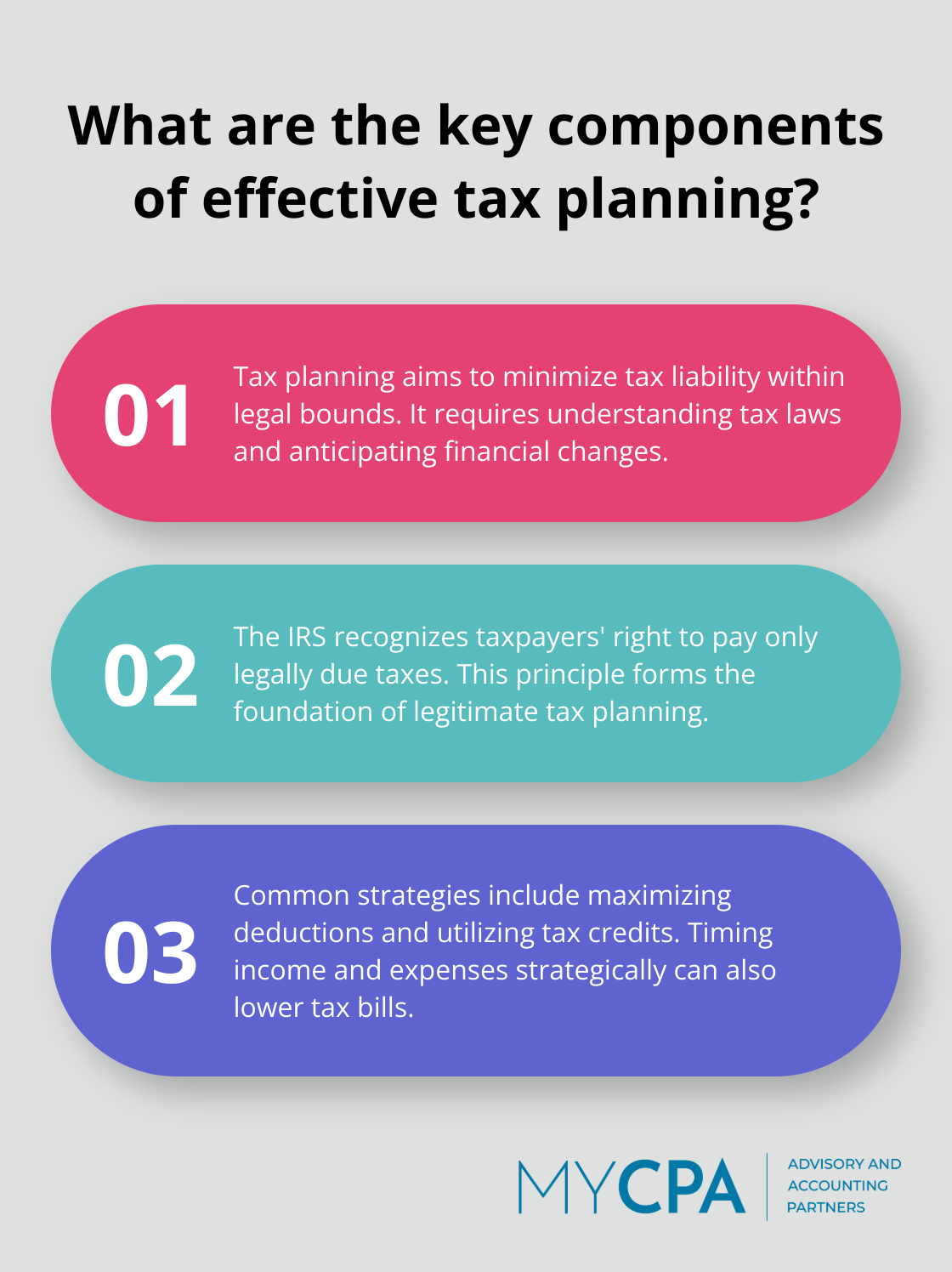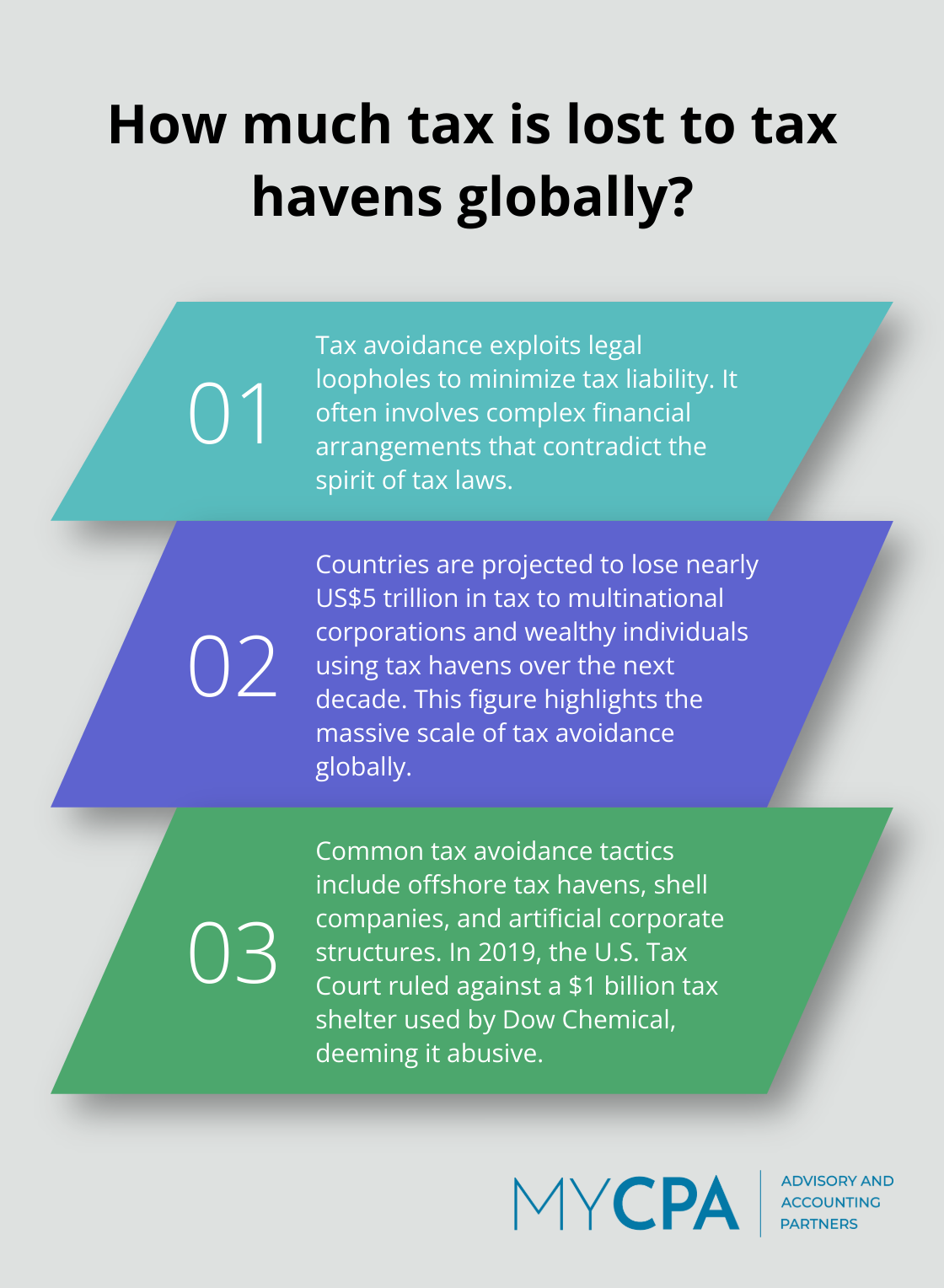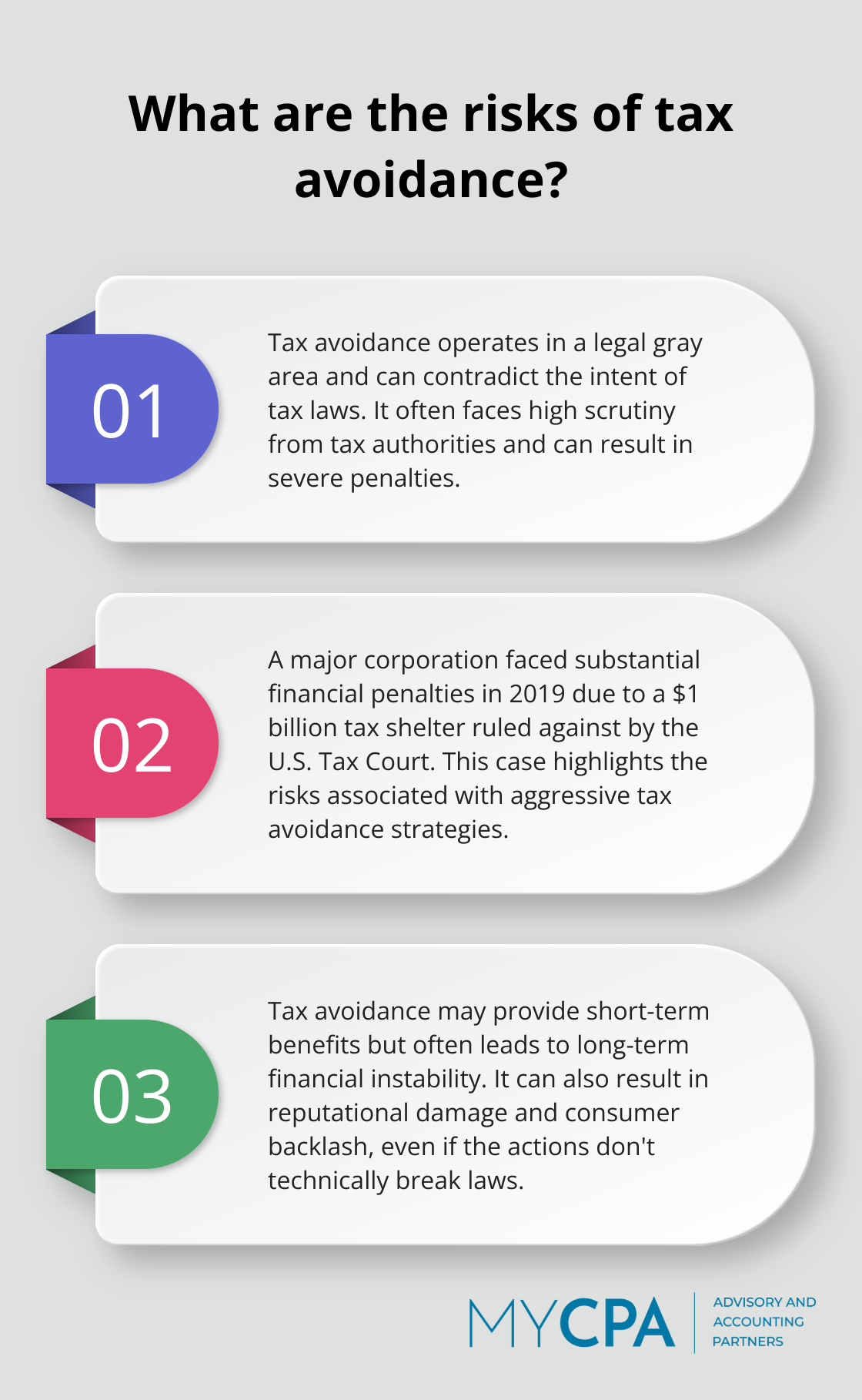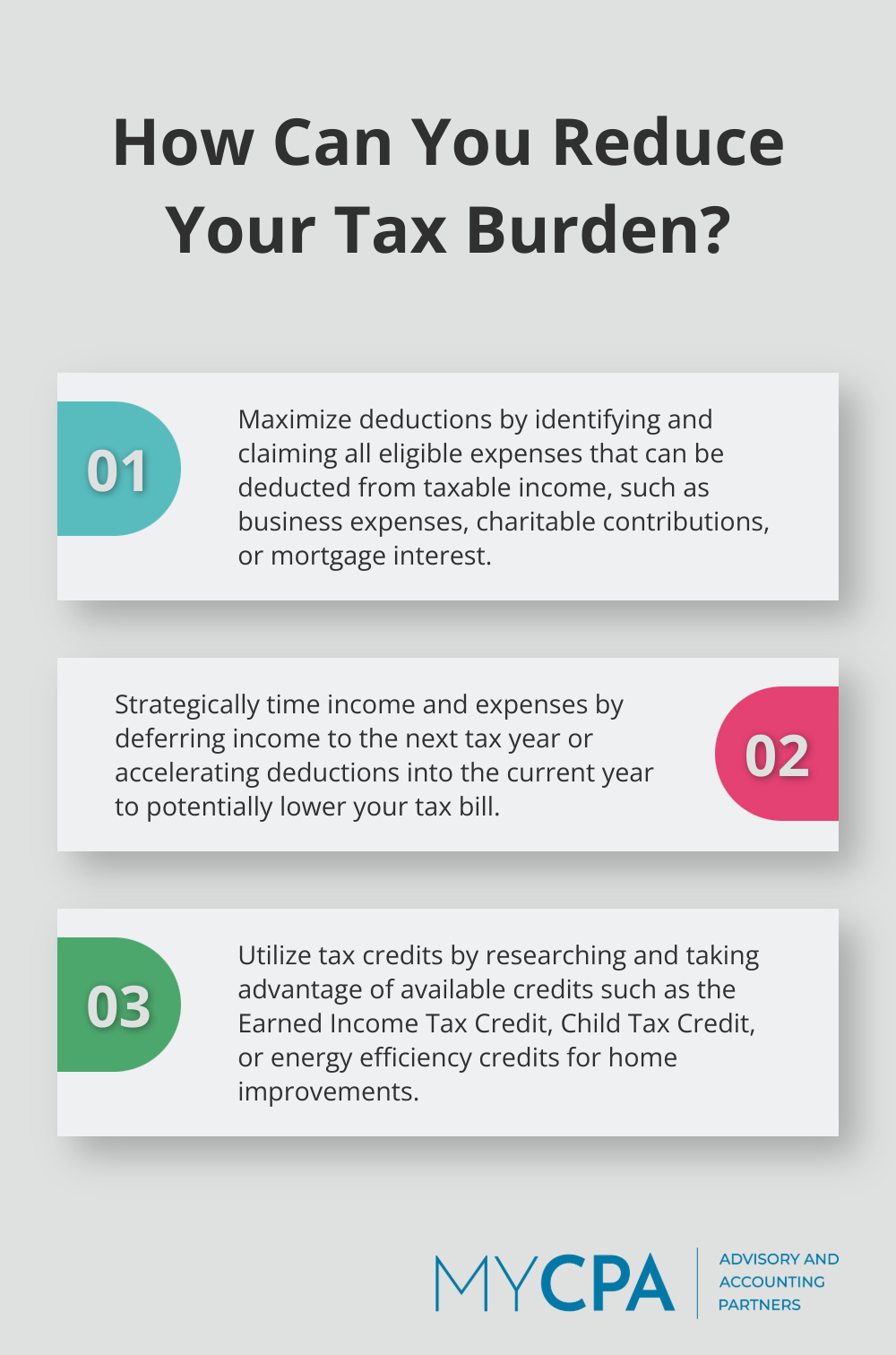
At My CPA Advisory and Accounting Partners, we often encounter confusion about the difference between tax planning and tax avoidance.
While both aim to reduce tax liability, they’re fundamentally different in their approach and legality. Understanding these distinctions is vital for businesses and individuals alike.
This blog post will clarify the key differences, helping you make informed decisions about your tax strategy.
Tax planning is a strategic approach to managing finances with the goal of minimizing tax liability within the bounds of the law. It forms an essential part of overall financial management for both individuals and businesses.
Tax planning involves analyzing your financial situation and making informed decisions to reduce your tax burden. This process requires a thorough understanding of tax laws and regulations, as well as the ability to anticipate future changes in your financial circumstances.
The Internal Revenue Service (IRS) acknowledges that taxpayers have the right to pay only the amount of tax legally due, including interest and penalties. This principle forms the foundation of legitimate tax planning.
Numerous legal strategies exist to reduce tax liability. Some common methods include:
Proactive tax planning offers significant benefits. It can help individuals and businesses minimize their taxable income while saving for retirement and maximizing deductions.
Effective tax planning extends beyond the current tax year. It considers long-term financial goals and helps create a roadmap to achieve them. For instance, a business owner might structure their company in a way that provides tax benefits not just for the current year, but for years to come.

As we move forward, it’s important to understand the distinction between tax planning and tax avoidance. While tax planning involves legal methods to reduce tax liability, tax avoidance often treads a fine line between legality and illegality. Let’s explore this concept in more detail.
Tax avoidance pushes the boundaries of tax law to minimize tax liability. Unlike tax planning, which operates within clear legal parameters, tax avoidance often exploits loopholes or ambiguities in tax legislation.
Tax avoidance schemes typically involve complex financial arrangements designed to reduce tax obligations. These schemes may appear legal on the surface but often contradict the spirit of tax laws. The IRS and other tax authorities frequently challenge such arrangements, which leads to potential legal battles and financial penalties.
Some prevalent tax avoidance strategies include:
For instance, a company might set up a subsidiary in a low-tax jurisdiction to shift profits and reduce overall tax liability. Another tactic involves the creation of complex loan arrangements between related entities to manipulate taxable income.

A study by the Tax Justice Network reveals that countries are on course to lose nearly US$5 trillion in tax to multinational corporations and wealthy individuals using tax havens to underpay over the next decade. This staggering figure underscores the scale of the issue and its impact on global economies.
The legal status of tax avoidance schemes often remains unclear until challenged in court. Many schemes that were once considered legal have later been ruled as tax evasion. For example, in 2019, the U.S. Tax Court ruled against a $1 billion tax shelter used by Dow Chemical, deeming it abusive.
Ethically, tax avoidance raises questions about corporate social responsibility and fair contribution to society. Companies that engage in aggressive tax avoidance may face reputational damage and consumer backlash. The use of the term tax avoidance, as distinguished from tax evasion, does not itself imply any illegal activity on the part of the firm.
The risks associated with tax avoidance far outweigh any potential short-term benefits. Instead of engaging in these risky practices, businesses and individuals should focus on legitimate tax planning strategies that align with both the letter and spirit of tax laws.
As we move forward, it’s essential to understand the key differences between tax planning and tax avoidance. These distinctions will help you make informed decisions about your tax strategy and avoid potential legal and ethical pitfalls.
Tax planning and tax avoidance differ significantly in their intent. Tax planning is the analysis and arrangement of a person’s financial situation to maximize tax breaks and minimize tax liabilities in a legal and efficient manner. Tax avoidance, however, often exploits loopholes or ambiguities in tax legislation. This fundamental difference shapes the approach and outcomes of each strategy.
Tax planning adheres strictly to both the letter and spirit of tax laws. It involves using legitimate deductions, credits, and strategies approved by tax authorities. Tax avoidance, on the other hand, operates in a gray area. It may technically comply with the law but often contradicts its intent (leading to potential legal challenges).
The risk levels associated with tax planning and tax avoidance vary greatly. Tax planning, when executed correctly, carries minimal risk. It provides a stable foundation for financial decisions. Tax avoidance schemes, however, face high scrutiny from tax authorities. They can result in severe penalties, legal battles, and reputational damage.

For instance, in 2019, a major corporation faced substantial financial penalties when the U.S. Tax Court ruled against its $1 billion tax shelter. This case highlights the risks of aggressive tax avoidance strategies.
Effective tax planning contributes to long-term financial stability and growth. It allows businesses and individuals to make informed decisions about investments and financial strategies. Tax avoidance may provide short-term benefits but often leads to long-term financial instability.
Tax planning aligns with ethical business practices and corporate social responsibility. It demonstrates a commitment to fair contribution to society. Tax avoidance, however, raises ethical questions. Companies engaging in aggressive tax avoidance may face consumer backlash and reputational damage (even if their actions don’t break any laws).
The difference between tax planning and tax avoidance lies in their approach and legality. Tax planning operates within the law to minimize tax obligations, while tax avoidance exploits loopholes, often contradicting the spirit of tax laws. Tax avoidance might offer short-term gains, but it carries significant risks, including legal battles, financial penalties, and reputational damage.

Ethical tax strategies contribute fairly to society and maintain a positive reputation. Focusing on legitimate tax planning methods helps businesses and individuals achieve financial stability without compromising integrity. Smart tax planning builds a solid foundation for your financial future (and provides peace of mind).
We at My CPA Advisory and Accounting Partners specialize in effective and ethical tax planning. Our team can help you navigate complex tax laws, ensuring you take advantage of all legal opportunities to minimize your tax liability. We provide personalized strategies tailored to your specific financial situation, helping you achieve your financial goals.








Privacy Policy | Terms & Conditions | Powered by Cajabra